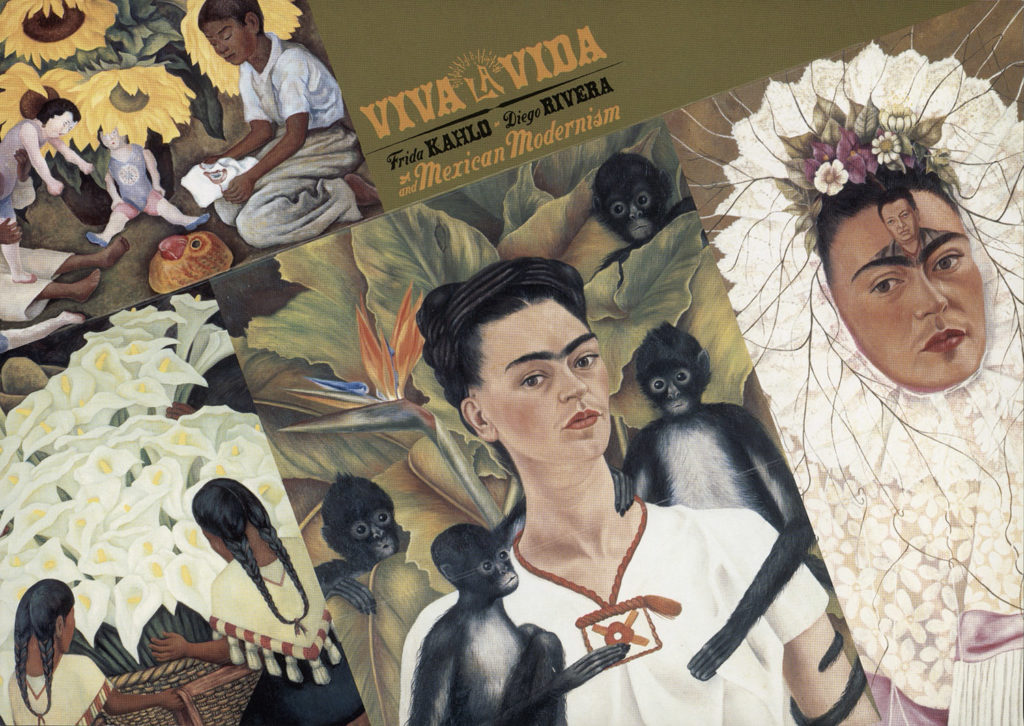ARTISTS Frida Kahlo, Emilio Baz Viaud, Miguel Calderon, Leonora Carrington, Rafael Cidoncha, Elena Climent, Miguel Covarrubias, Gunther Gerzso, Sergio Hernandez, Maria Izquierdo, Cisco Jimenez, Agustin Lazo, Carlos Merida, Roberto Montenegro, Jose Clemente Orozco, Carlos Orozco Romero, Paula Santiago, David Alfaro Siqueiros, Juan Soriano, Gerardo Suter, Rufino Tamayo, Francisco Toledo, German Venegas and Angel Zarraga CURATOR Robert Littman PUBLICATION essays Gregory O'Brien, Paula Savage, Lara Strongman SPONSORS Russell McVeagh, Telecom, Saatchi and Saatchi, New Zealand Government
Viva La Vida: Frida Kahlo, Diego Rivera, and Mexican Modernism presents key works of twentieth-century Central American art from the Jacques and Natasha Gelman Collection. A ‘coup’, the show is the result of years of negotiations by City Gallery Director Paula Savage. It also needed Prime Minister Jenny Shipley to convince Mexican President Ernesto Zedillo to waive the normal bond charged for Mexican masterpieces leaving the country—a major obstacle to staging the show.
The show centres on the work of painters and lovers Frida Kahlo and Diego Rivera. He was twenty years her senior. They had a fiery but destructive relationship. Both were unfaithful, jealous, obsessive. A photo essay of their life accompanies the exhibition, with photos by leading photographers, friends, and family.
Kahlo is the star of the show. A freak accident when she was young rendered her almost a cripple. Her art became an escape—she painted from her bed. Her pictures express her identity, while referring to local customs and iconography. Eleven of her twelve works in the show are self-portraits, where costumes, props, and companions play on allegorical role. In Self Portrait as Tehuana (Diego on My Mind) (1943), she wears a Tehuana headdress, signifying a traditionally matriarchal part of south-west Mexico. Diego Rivera, her husband, is placed in the centre of her forehead, suggesting he's an inescapable presence, ever in her thoughts. A Listener review claims: ‘To artists, feminists and romantics the world over, Kahlo’s life possesses all of the ingredients necessary for a myth to take root in the collective psyche.’
Rivera was a renowned muralist, undertaking large commissions for the Socialist government that envision a bright, heroic future. His paintings offer interpretations of his natural environment and traditional life. Although considering similar themes as Kahlo, his style is very different. Calla Lily Vendor (1943) is one of his most significant easel works. Two young girls in traditional dress have their backs to us as they attend to a hoard of lilies. Lilies also appear in Rivera's Portrait of Natasha Gelman (1943).
There are works by other artists, including David Alfaro Siqueiros and José Clements Orozco—contemporaries of Rivera—who created ambitious public murals in Mexico in the 1930s.
There is at least one artist to represent each decade following Rivera and Kahlo. Guatemalan-born Carlos Mérida’s work shows the influence of Mayan textiles, biomorphic abstraction, and Guatemalan tradition. It’s been compared to the work of Klee and Kandinsky.
A number of contemporary artists in the collection are also exhibited. Visiting collection curator Magda Carranza explains, ‘Mexico is much more than just Kahlo and Rivera, the muralists, and well-known artists ... there are literally thousands of artists in Mexico. Miguel Calderón is the youngest artist in the show. Two photos from his series, Artificial History (1995), present a crazed protagonist wielding a gun at a stuffed tiger and a stuffed zebra. The artist snuck into a natural-history museum diorama to stage the shots. They comment on the museum as a European framework in Central American culture.
The public programme is busy. Academics, artists, and writers respond to the show. Elizabeth Knox, Fiona Pardington, and Séraphine Pick address to Kahlo’s self-portraiture. Actress Jillian Tipene’s solo show recreates Frida Kahlo’s life through poetry, images, and music. There are readings of works by Mexican poets. The Education programme has a piñata-making workshop; piñata suspended in the Gallery entrance way are smashed open by school children. Merch sells out.































































































































